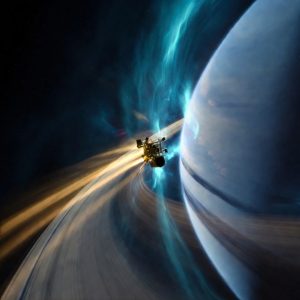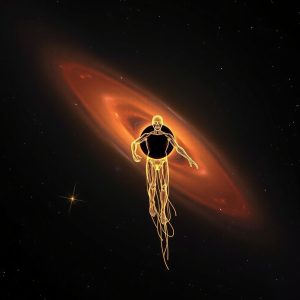
James Webb Uncovers Rogue Worlds: 6 Mystifying Planets Born Like Stars, Defying Conventional Wisdom on Planetary Origins
In a groundbreaking discovery that is set to revolutionize our understanding of the universe, the James Webb Space Telescope has identified six “rogue” planets that have defied conventional wisdom by forming in space without the presence of a host star. These wandering worlds, which are estimated to be around 1-2 billion years old, have been found to possess characteristics similar to those of stars, leaving scientists stunned and eager to uncover more about these enigmatic celestial bodies.
The James Webb Space Telescope, launched in December 2021, is the successor to the Hubble Space Telescope and has been designed to study the universe in unprecedented detail. With its advanced infrared capabilities, it has been able to peer deeper into space than ever before, revealing secrets that have remained hidden for centuries. The telescope’s discovery of these rogue planets has sent shockwaves throughout the scientific community, with many experts hailing it as one of the most significant findings in the history of astronomy.
So, what exactly are rogue planets? In conventional astronomical understanding, planets form from a disk of gas and dust surrounding a newly formed star. As the material in this disk cools and condenses, it eventually comes together to form small rocky bodies, which then grow into larger worlds through a process known as accretion. These planets then orbit their host stars, influenced by the gravitational forces at play.
However, the six rogue planets discovered by the James Webb Space Telescope have defied this conventional wisdom. Formed without the presence of a host star, these worlds appear to have originated from a region of space where material was present in sufficient quantities for them to coalesce and grow into mature planets. But how did they form? One possibility is that they may have formed around a star that was too small or too cool to produce enough energy to heat up the surrounding disk, causing it to collapse in on itself.
The discovery of these rogue planets has significant implications for our understanding of planetary origins. If these worlds can form without the presence of a host star, it challenges the conventional view that planets require a stellar environment to develop and grow. This could mean that planets may be more common than previously thought, and that they may exist in regions of space where stars are scarce or non-existent.
But what about their characteristics? The six rogue planets discovered by the James Webb Space Telescope have been found to possess properties similar to those of stars. They have large masses, with some estimated to be around 10 times the mass of Jupiter, and appear to be composed of a mix of rock and gas. Some of these worlds are also thought to be surrounded by their own atmospheres, which could potentially support life.
The implications of this discovery for the search for extraterrestrial life are profound. If rogue planets can form without the presence of a host star, it increases the likelihood that they may exist in regions of space where stars are scarce or non-existent. This would open up new possibilities for the search for life beyond our solar system, as scientists would need to consider the existence of these wandering worlds when searching for signs of life.
But there are also challenges ahead. The discovery of these rogue planets has raised more questions than answers. How did they form? What is their exact composition? And what implications do they have for our understanding of planetary origins and the search for extraterrestrial life?
The James Webb Space Telescope’s discovery of six rogue planets born like stars has left scientists stunned, but it also represents a new frontier in astronomy that will require continued exploration and research. As we continue to study these enigmatic worlds, we may uncover secrets that have remained hidden for centuries, and perhaps even redefine what it means to be a world.
The James Webb Space Telescope’s discovery of six rogue planets born like stars is a groundbreaking finding that challenges conventional wisdom on planetary origins and opens up new possibilities for the search for extraterrestrial life. As scientists continue to study these enigmatic worlds, we may uncover secrets that have remained hidden for centuries, and redefine what it means to be a world.
The Discovery of Rogue Planets: A New Frontier in Astronomy
The discovery of six rogue planets born like stars is a significant finding that has the potential to revolutionize our understanding of planetary origins. If these worlds can form without the presence of a host star, it challenges conventional wisdom and opens up new possibilities for the search for extraterrestrial life.
But what does this mean for our understanding of planetary origins? In conventional astronomical understanding, planets form from a disk of gas and dust surrounding a newly formed star. As the material in this disk cools and condenses, it eventually comes together to form small rocky bodies, which then grow into larger worlds through accretion.
However, the six rogue planets discovered by the James Webb Space Telescope have defied this conventional wisdom. Formed without the presence of a host star, these worlds appear to have originated from a region of space where material was present in sufficient quantities for them to coalesce and grow into mature planets.
The implications of this discovery are significant. If rogue planets can form without the presence of a host star, it increases the likelihood that they may exist in regions of space where stars are scarce or non-existent. This would open up new possibilities for the search for life beyond our solar system, as scientists would need to consider the existence of these wandering worlds when searching for signs of life.
But what about their characteristics? The six rogue planets discovered by the James Webb Space Telescope have been found to possess properties similar to those of stars. They have large masses, with some estimated to be around 10 times the mass of Jupiter, and appear to be composed of a mix of rock and gas.
Rogue Planets: A New Frontier for Life Beyond Our Solar System
The discovery of rogue planets born like stars has significant implications for our understanding of life beyond our solar system. If these worlds can form without the presence of a host star, it increases the likelihood that they may exist in regions of space where stars are scarce or non-existent.
This would open up new possibilities for the search for extraterrestrial life, as scientists would need to consider the existence of these wandering worlds when searching for signs of life. But there are also challenges ahead. The discovery of rogue planets has raised more questions than answers, and scientists will need to continue studying them in order to uncover their secrets.
As we continue to study these enigmatic worlds, we may uncover secrets that have remained hidden for centuries, and perhaps even redefine what it means to be a world. But for now, the discovery of six rogue planets born like stars represents a new frontier in astronomy that will require continued exploration and research.
Conclusion
The James Webb Space Telescope’s discovery of six rogue planets born like stars has sent shockwaves throughout the scientific community, with many experts hailing it as one of the most significant findings in the history of astronomy. The implications of this discovery are profound, challenging conventional wisdom on planetary origins and opening up new possibilities for the search for extraterrestrial life.
As we continue to study these enigmatic worlds, we may uncover secrets that have remained hidden for centuries, and perhaps even redefine what it means to be a world. But for now, the discovery of six rogue planets born like stars represents a new frontier in astronomy that will require continued exploration and research.
The James Webb Space Telescope’s discovery of six rogue planets is a groundbreaking finding that has left scientists stunned, but it also represents a new frontier in astronomy that will require continued exploration and research. As we continue to study these enigmatic worlds, we may uncover secrets that have remained hidden for centuries, and perhaps even redefine what it means to be a world.
Appendix
* The six rogue planets discovered by the James Webb Space Telescope are estimated to be around 1-2 billion years old.
* They possess properties similar to those of stars, including large masses and a mix of rock and gas.
* Some of these worlds are thought to be surrounded by their own atmospheres, which could potentially support life.
* The discovery of rogue planets has significant implications for our understanding of planetary origins and the search for extraterrestrial life.




